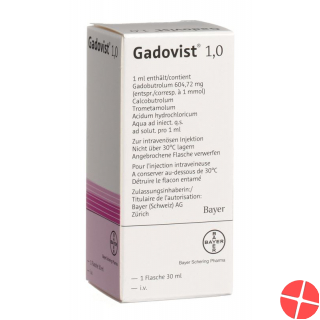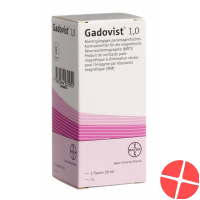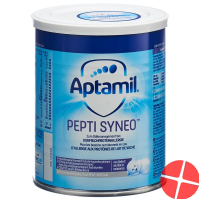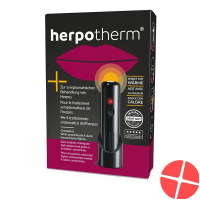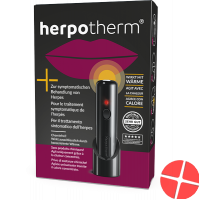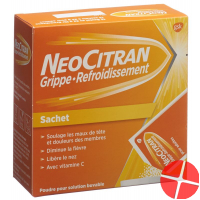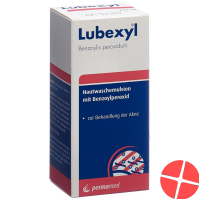Gastrografin solution bottle 100 ml
Gastrografin Lös Fl 100 ml
-
77.11 CHF
- Price in reward points: 3131

- Availability: In stock
- Brand: BAYER PHARMACEUTICALS
- Product Code: 1416398
- ATC-code V08AA01
- EAN 7680276200354
Ingredients:
iodine, sodium amidotrizoate, meglumine amidotrizoate, star anise oil, sodium, disodium edetate, saccharin sodium, polysorbate 80

Variants
Gastrografin Lösung 10 Flasche 100ml
354.73 CHF
Description
composition
Active ingredients
Natrii amidotrizoas, meglumini amidotrizoas.
Excipients
Dinatrii edetas, Saccharinum natricum, Polysorbatum 80, Anisi stellati aetheroleum, Aqua purificata.
Total sodium content: 373.59 mg per 100 ml.
Dosage form and amount of active ingredient per unit
Oral solution/rectal solution.
1 ml of gastroenteral solution contains Natrii amidotrizoas 100 mg and Meglumini amidotrizoas 660 mg (corresp. iodum 370 mg) as active ingredients.
100 ml of gastroenteral solution contains 10 g of Natrii amidotrizoas and 66 g of Meglumini amidotrizoas (Natrii diatrizoas and Meglumini diatrizoas), corresp. Iodine 37 g.
The physico-chemical properties of the ready-made solution Gastrografin are listed below:
Contrast agent concentration (mg/ml) | 760 |
Contrast agent content (g) per bottle of 100 ml | 76 |
Viscosity (mPa∙s or cP) | |
at 20°C | 18.5 |
at 37°C | 8.9 |
Osmotic pressure at 37 °C | |
(MPa) | 5.58 |
(atm) | 55.1 |
Osmolality at 37 °C (osm/kg) H 2 0 | 2.15 |
Osmolarity at 37 °C (osm/l sol.) | 1.42 |
Indications/applications
This medicine should only be used orally or rectally.
- Gastrografin is an X-ray contrast agent for imaging the gastrointestinal tract (also in combination with barium sulfate).
It is suitable for both oral administration and enema and is primarily used when the use of barium sulfate is unsatisfactory, undesirable or contraindicated. These include:
Suspicion of partial or complete stenosis, acute bleeding, impending perforation (peptic ulcer, diverticulum), other acute conditions that may require surgical intervention, before gastric and intestinal resections (risk of perforation, suture insufficiency), megacolon, appearance of foreign bodies and tumors Endoscopies, visualization of gastrointestinal fistulas.
In addition, Gastrografin can generally be used for the same indications as barium sulfate.
The routine examination of the gastrointestinal tract was significantly improved by the combination of gastrografin with barium sulfate, both from a diagnostic and organizational point of view (faster examination). It is not suitable for diagnosing enteritis.
Further areas of application:
- for early diagnosis of a radiographically invisible perforation or anastomotic leak in the esophagus and/or gastrointestinal tract;
- for the treatment of uncomplicated meconium ileus
- for computed tomography in the abdominal area. The risk of incorrect findings is much lower if the intestine is marked with gastrografin, especially for differential diagnoses in the small pelvis. Gastrografin facilitates the demarcation of the intestine from neighboring organs and enables the assessment of changes in the shape of the pancreas.
Dosage/Application
Gastrographer alone
Oral use
The dosage depends on the type of examination and the age of the patient.
Adults and children ≥10 years
Stomach absorption: 60 ml
Gastrointestinal passage: Maximum 100 ml
For old and cachectic patients, it is recommended to dilute with water in a 1:1 ratio.
For early diagnosis of a perforation or anastomotic leak in the esophagus and/or gastrointestinal tract, the patient drinks 100 ml of Gastrografin. If the suspected lesion cannot be clearly identified on the X-ray, a chemical reaction can be used for further clarification: After 30-60 minutes, or later if insufficiency in the aboral section of the intestine is suspected, a urine sample is taken and 5 drops of concentrated hydrochloric acid are added to 5 ml . If contrast medium leaks extraenterally, typical crystal formation occurs in the sediment within 2 hours.
Children
Infants and young children: 15-30 ml (diluted with water in a ratio of 1:3)
Children (under 10 years): 15-30 ml (pure or diluted with water in a ratio of 1:2)
Computed tomography (CT):
0.5 to 1.5 l of an approximately 3% Gastrografin solution (30 ml Gastrografin / 1 l water).
Rectal use (including treatment of uncomplicated meconium ileus)
Adult
Up to 500 ml Gastrografin dilution (diluted with water in a ratio of 1:3-1:4)
Unlike the barium sulfate enema, no more than 500 ml of this diluted solution is generally required.
Children
Children under 5 years: Up to 500 ml Gastrografin dilution (diluted with water in a ratio of 1:5)
Children over 5 years: Up to 500 ml of Gastrografin dilution (diluted with water in a ratio of 1:4-1:5)
Use in uncomplicated meconium ileus
For uncomplicated meconium ileaus, non-surgical treatment with gastrografin enemas can be attempted. The high osmotic pressure of gastrografin can be used therapeutically to resolve uncomplicated meconium ileus: considerable amounts of fluid are withdrawn from the surrounding tissue, which flow into the intestine and dissolve the thickened meconium. However, the hyperosmolarity of gastrografin can also lead to dehydration and electrolyte imbalances, which is why appropriate intravenous infusion treatment must be carried out beforehand and at the same time.
The enema may only be carried out with low pressure, slowly and under X-ray control. As soon as gastrografin gets into the ileum, the administration must be stopped. After removal of the rectal catheter, perforation must be ruled out radiologically. If no emptying occurs within 1 hour after removal of the rectal catheter, another radiological check should be carried out.
Gastrografin in combination with barium sulfate
Adults and children ≥10 years
In addition to the usual barium sulfate dose: 30 ml of gastrografin
Children
In addition to the usual barium sulfate dose:
Children under 5 years: 2-5 ml Gastrografin to 100 ml barium sulfate suspension
Children between 5 and 10 years: 10 ml Gastrografin to 100 ml barium sulfate suspension.
If necessary (in cases of pylorospasm or pyloric stenosis), the proportion of gastrografin in the suspension can be further increased without compromising contrast.
X-rays
Stomach images are taken in the usual way when using Gastrografin alone or in combination with barium sulfate.
The gastric emptying times are the same as for barium porridge. The filling process in the intestine, on the other hand, is accelerated. With pure Gastrografin, the passage is generally completed after just 2 hours, while with Gastrografin-barium sulfate mixture it can take up to 3 hours, and in individual cases even longer.
The urge to defecate that all patients report is the best sign that the best time for colon imaging has come.
Contraindications
Hypersensitivity to the active ingredient or one of the excipients according to the composition.
Gastrografin should not be used undiluted in patients with low plasma volume, such as neonates, infants, children and dehydrated patients, as hypovolemic complications may be particularly severe in these patients.
In patients with suspected possible aspiration or esophagobronchial fistula, Gastrografin should not be used undiluted as hyperosmolarity can lead to acute pulmonary edema, chemical pneumonia, respiratory collapse and death.
Warnings and Precautions
The risks mentioned below are higher in the case of intravascular administration of iodine-containing contrast media, but are also relevant when using gastrografin enterally.
In cases of hypersensitivity to iodine-containing contrast media, latent hyperthyroidism, bland nodular goiters, dehydrated patients, as well as infants and small children, the indication for examination with Gastrografin must be particularly strict.
Hypersensitivity
In patients with a previous anaphylactoid or hypersensitivity reaction to Gastrografin or one of its ingredients or to other iodine-containing contrast media, a particularly careful benefit/risk assessment is required due to the increased risk of anaphylactoid or hypersensitivity reactions.
Like other intravenously administered contrast agents, gastrografin may be associated with anaphylactoid, hypersensitivity or other idiosyncratic reactions, which may manifest as cardiovascular, respiratory or skin disorders, up to severe reactions including shock.
Delayed reactions may occur (after hours to days) (see “Adverse effects”).
The risk of hypersensitivity reactions is increased in the following cases:
- History of allergic disorders
- History of bronchial asthma
- previous reactions to iodine-containing contrast media
The personnel requirements for emergency treatment of hypersensitivity reactions must be met and the necessary material must be ready for use.
It is essential to be familiar with the application of emergency measures.
After the administration of contrast medium, the patient should remain under supervision for at least 30 to 60 minutes, as experience shows that the majority of all serious incidents occur within this time (see “Adverse effects”).
Hypersensitivity reactions may worsen in patients taking beta-blockers. Patients who experience such reactions while taking beta-blockers may not respond to treatment of the anaphylactoid or hypersensitivity reaction with beta-agonists.
Patients with cardiovascular disease are at increased risk of serious or even fatal anaphylactoid or hypersensitivity reactions.
Thyroid function disorders
Particularly careful benefit/risk assessment is required in patients with known or suspected hyperthyroidism or goiter, as iodine-containing contrast media can influence thyroid function and can aggravate or trigger hyperthyroidism and a thyrotoxic crisis.
In patients with known or suspected hyperthyroidism, thyroid function evaluation and/or preventive antithyroid medication should be considered prior to administration of Gastrografin.
In newborns, especially premature infants, exposed to Gastrografin either through the mother during pregnancy or in the neonatal period, it is recommended that thyroid function be monitored as exposure to excess iodine may cause hypothyroidism, which may require treatment.
Combination with barium sulfate
If Gastrografin is used in combination with preparations containing barium sulfate, the contraindications, warnings and possible undesirable effects of the respective preparation must be taken into account.
Gastrointestinal tract
In the event of prolonged retention in the gastrointestinal tract (e.g. obstruction, stasis), tissue damage, bleeding, intestinal necrosis and intestinal perforation may occur. When used rectally to treat a meconium leak, perforations are reported in 2.7% to 23%, depending on the literature and the circumstances.
fluid balance
Adequate hydration and electrolyte balance of patients should be ensured and maintained as gastrografin hyperosmolarity can cause dehydration and electrolyte imbalance.
Disturbances in the water and electrolyte balance must be corrected before the examination.
Due to its high osmotic pressure and low intestinal absorption, gastrografin should not be given a higher dose than recommended in infants and young children.
Among other things, because of the additives (flavor correctors and a solubilizer), Gastrografin is not suitable for intravascular administration.
Sodium content in Gastrografin alone
This medicine contains 373.59 mg sodium per 100 ml, equivalent to 18.7% of the WHO recommended maximum daily dietary sodium intake of 2 g for an adult.
Interactions
Interactions with diagnostic tests
The ability of the thyroid tissue to absorb radioisotopes for thyroid diagnostics is reduced by iodine-containing renal x-ray contrast media for up to 2 weeks, or longer in individual cases.
Interleukin-2
Previous treatment with interleukin-2 (up to several weeks) is associated with an increased risk of late reactions to gastrografin.
Pregnancy/breastfeeding
pregnancy
Reproductive toxicological studies following intravenous administration of meglumine or sodium amidotrizoate revealed no evidence of teratogenic or embryotoxic potential. However, the safety of using Gastrografin during pregnancy has not been proven in humans. Since radiation exposure should be avoided as much as possible during this time, an X-ray examination with or without contrast medium should not be carried out unless it is absolutely necessary.
If a contrast medium examination is essential during pregnancy, the pronounced sensitivity of the fetal thyroid to iodine should always be taken into account.
lactation
Since there is no information about possible excretion into breast milk, use during breastfeeding is not recommended.
Effects on the ability to drive and operate machines
No relevant studies were undertaken. The patient's condition and undesirable effects must be taken into account.
unwanted effects
Side effects associated with the use of iodine-containing contrast media are usually mild to moderately severe and temporary in nature. However, cases of serious and life-threatening reactions and deaths have also been reported.
Vomiting, nausea and diarrhea are the most commonly observed reactions. The majority of the side effects listed below were not observed in controlled studies, but come from literature information and pharmacovigilance observations. Reliable frequency information is therefore not possible.
Immune system diseases
Anaphylactoid shock, anaphylactoid or hypersensitivity reaction.
Endocrine diseases
Hyperthyroidism.
Hypothyroidism.
Metabolic and nutritional disorders
Disturbances of fluid and electrolyte balance.
Diseases of the nervous system
Impaired consciousness, headache, dizziness/lightheadedness.
Heart disease
Cardiac arrest, tachycardia, Kounis syndrome.
Vascular diseases
Shock, hypotension.
Respiratory, thoracic and mediastinal diseases
Bronchospasm, dyspnea, drug aspiration, pulmonary edema after aspiration, aspiration pneumonia.
Diseases of the gastrointestinal tract
Vomiting, nausea, diarrhea.
Intestinal perforation, abdominal pain, blistering of the oral mucosa.
Diseases of the skin and subcutaneous tissue
Lyell's syndrome (toxic epidermal necrolysis), urticaria, rash, pruritus, erythema, facial edema.
General disorders and administration site conditions
Pyrexia, sweating.
The hypertonic gastrografin solution occasionally leads to diarrhea, which, however, quickly stops after emptying the bowel. Existing enteritis or colitis may temporarily worsen. Nausea and vomiting are exceptions. Urticarial skin reactions have rarely been observed; anaphylactoid reactions up to shock are possible.
Reporting suspected side effects after approval is of great importance. It enables continuous monitoring of the benefit-risk ratio of the drug. Healthcare professionals are asked to report any suspected new or serious side effects via the online portal ElViS (Electronic Vigilance System). You can find information about this at www.swissmedic.ch.
Overdose
Acute symptoms of poisoning are not to be expected when administered orally. In the presence of perforating gastrointestinal ulcers, no acute toxic effects are expected when the diagnostic dose is administered if partial amounts enter the abdominal cavity. Possible chronic toxic effects (inflammatory changes) are prevented by the necessary surgical procedure with appropriate abdominal toilet.
Hypersensitivity reactions to sodium and meglumine amidotrizoate are, as with any iodine-containing X-ray contrast agent, possible even after oral administration, although they occur very rarely. The type and severity of the incidents can vary greatly, as is generally the case with iodine-containing X-ray contrast media. Medicines (e.g. corticosteroids), a tracheal tube and a ventilator should therefore be available for therapy.
Properties/Effects
Pharmacotherapeutic group: water-soluble, nephrotrophic, high-osmolar X-ray contrast agent.
ATC code
V08AA01
Mechanism of action
The contrast-providing substance is a salt mixture of amidotrizoic acid, in which the stably bound iodine absorbs the X-rays.
Pharmacodynamics
See also under “Mechanism of Action”.
Clinical effectiveness
Not applicable.
Pharmacokinetics
Only about 3% of amidotrizoic acid is absorbed from the stomach and intestines. This portion, as well as any contrast medium that may enter the organism through perforations, is excreted quickly and completely, primarily via the kidneys.
absorption
See also “Pharmacokinetics”.
distribution
Not applicable.
metabolism
Not applicable.
elimination
Not applicable.
Preclinical data
Systemic tolerance tests in animals with meglumine and sodium amidotrizoate after single and repeated daily intravenous administration did not produce any findings that speak against the generally single diagnostic use in humans.
Mutagenesis and carcinogenicity
Genotoxicity studies (gene, chromosome and genomic mutation tests) with the salt mixture of sodium and meglumine midotrizoate in vitro and in vivo did not provide any evidence of mutagenic potential of gastrografin.
There are no studies on carcinogenicity.
In animal studies there was no evidence of a risk of teratogenicity, fertility disorders or disorders of fetal, perinatal or postnatal development.
In animal studies, after oral and rectal administration of sodium and meglumine amidotrizoate (up to 15 times the clinical dose), predominantly mild and, more rarely, moderate changes in the colonic mucosa occurred. All changes were reversible and disappeared after a few hours.
Contact sensitization studies did not indicate any potential for meglumine amidotrizoate in this regard. However, many years of clinical experience with Gastrografin show that anaphylactoid reactions, such as those known to other iodine-containing contrast agents, can occur.
Other information
Incompatibilities
The medicine may only be mixed with the medicines listed under “Dosage/Application”.
Influencing diagnostic methods
Thyroid diagnostics with radioisotopes (see “Interactions”).
durability
The medicine may only be used until the date marked “EXP” on the pack.
Durability after opening
Contrast solution that has not been used up 72 hours after opening the bottle must be discarded.
Special storage instructions
Do not store above 25°C.
Store away from light and x-rays.
Keep out of reach of CHILDREN.
Instructions for handling
At temperatures below +7 °C, gastrografin tends to crystallize, but this can be reversible by gently warming and shaking. This does not affect the effectiveness and stability of the preparation.
The preparation should be visually inspected for particles before administration. Only a clear, particle-free solution should be used.
Unused contrast solution or waste material should be disposed of in accordance with local requirements.
Approval number
27620 (Swissmedic).
Authorization holder
Bayer (Switzerland) AG, 8045 Zurich.
Reviews (0)
Recently Viewed

Free consultation with an experienced pharmacist
Describe the symptoms or the right drug - we will help you choose its dosage or analogue, place an order with home delivery or just consult.
We are 14 pharmacists and 0 bots. We will always be in touch with you and will be able to communicate at any time.






